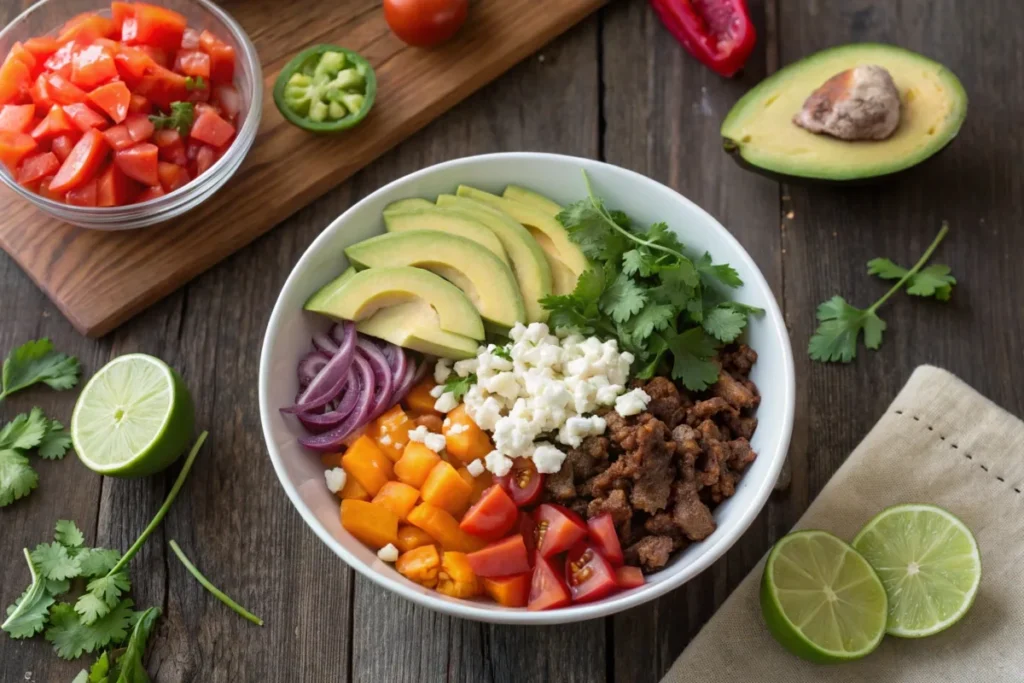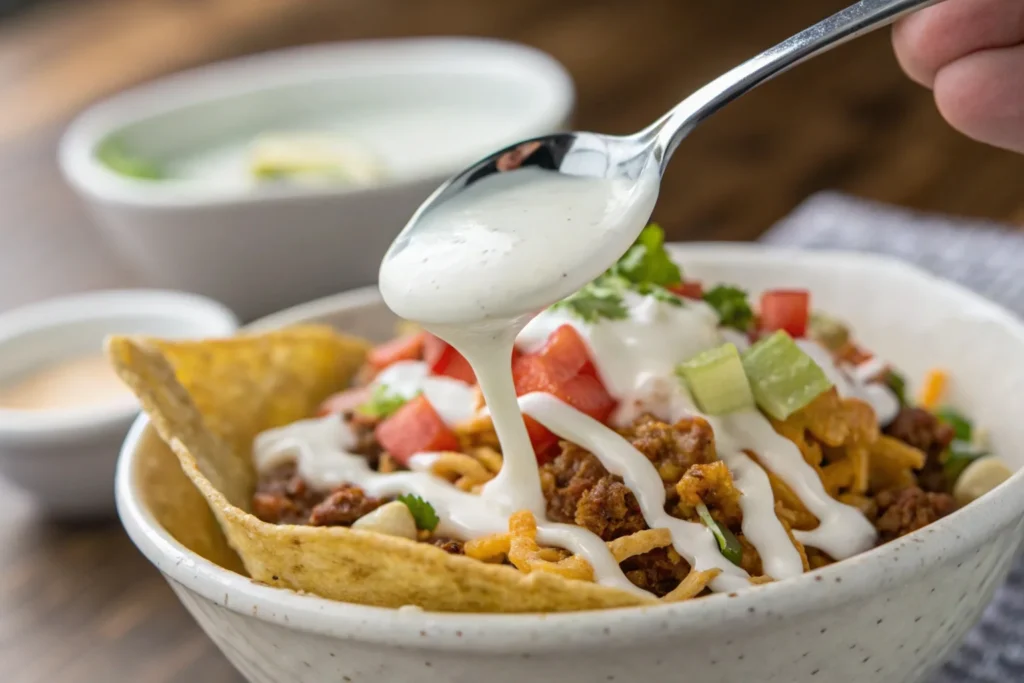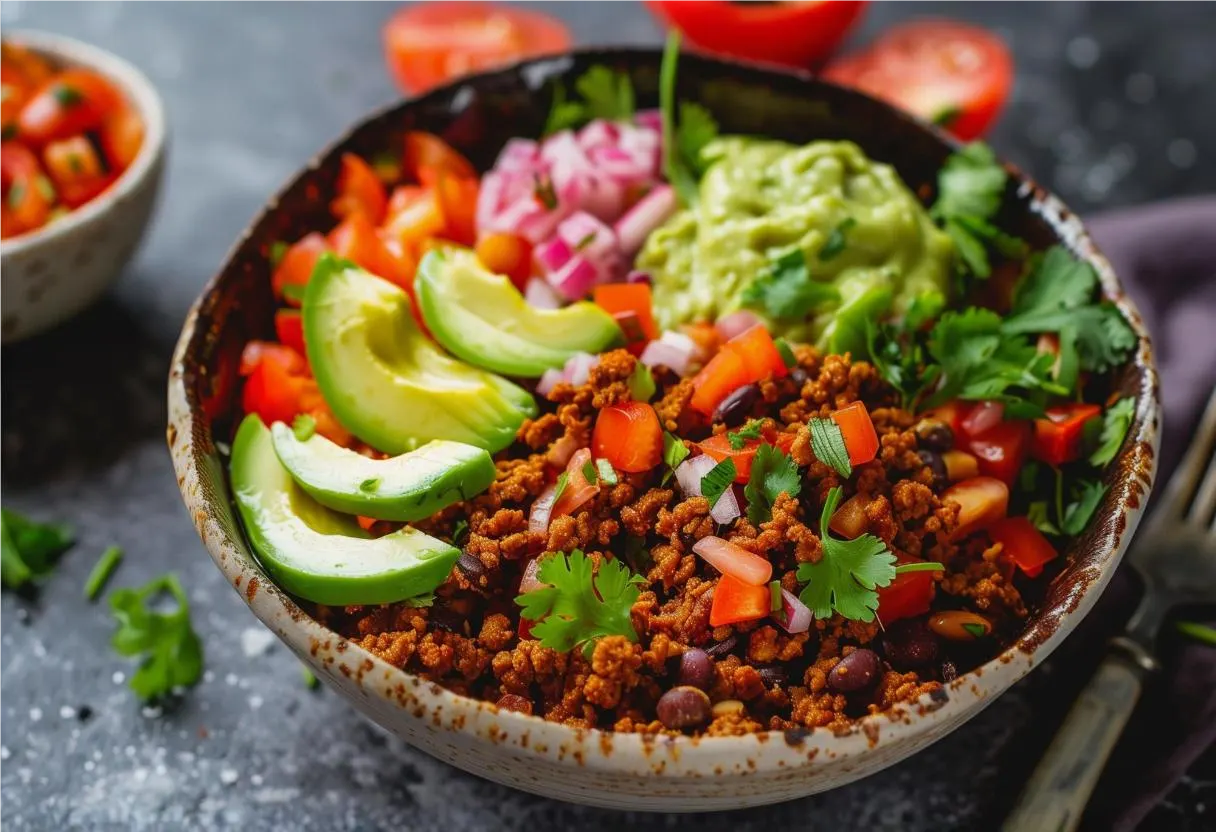Create a fresh, hearty homemade taco bowl recipe, loaded with vibrant veggies and flavor.
Introduction
When you think of a taco, you might picture a handheld delight bursting with seasoned meat, crisp lettuce, and ripe tomatoes. However, imagine capturing that same vibrant flavor, color, and satisfying crunch in a single bowl. A homemade taco bowl recipe is a fresh twist on a classic favorite. It blends tender proteins, fluffy rice, crisp vegetables, and creamy accents into one balanced, eye-catching meal. In addition, this dish is highly versatile, allowing you to tailor each layer to your personal taste. From choosing lean proteins to swapping in whole grains or adding more veggies, there are endless possibilities.
Because taco bowls have taken center stage in Tex-Mex and fusion-inspired meals, you are likely to find them at casual family dinners and weekend gatherings. They deliver rich flavor and balanced nutrition while still feeling special. Therefore, this article will walk you through the history, essential ingredients, step-by-step instructions, and helpful variations, ensuring that you create a homemade taco bowl brimming with flavor and freshness. In fact, by the end of this guide, you will know exactly how to craft a taco bowl so delicious that it may soon replace your standard taco night routine.
Table of Contents
The Concept & Origins of Taco Bowls
The Evolution of the Taco Bowl
Taco bowls, also sometimes called taco salads, are an American-born spin on traditional Mexican flavors. They emerged from the desire to transform handheld tacos into a fork-friendly meal that could combine all the best taco components—meat, beans, lettuce, salsa, and cheese—into one hearty dish. Over time, this innovative approach spread across the United States, influencing the menus of both fast-casual chains and upscale restaurants.
Cultural Fusion and Popularity
Many believe that Tex-Mex cuisine arose from cultural blending along the U.S.-Mexico border. Therefore, the taco bowl exemplifies this fusion. Although the concept started as a variation of the taco, it soon grew into a unique culinary icon, enjoyed by people seeking balanced meals, vegetarians looking for protein-rich salads, and health-conscious diners watching their calorie intake.
Why Taco Bowls are So Appealing
Because taco bowls are completely customizable, they have become a household favorite. You can easily adjust the level of heat, swap proteins, or add extra toppings. In addition, taco bowls can cater to various dietary needs, from gluten-free to vegan. They also present beautifully, making them a great option for entertaining guests—everyone can build their own bowl and explore new flavor combinations.
For more authentic, rich flavors, consider trying our Mexican beef stew with authentic flavors to expand your culinary repertoire.
Ingredient Breakdown: Building the Perfect Taco Bowl
Choosing the Right Protein
When assembling a homemade taco bowl recipe, the protein sets the tone. Therefore, you should pick wisely. Lean ground turkey or chicken work wonderfully for lighter bowls, while ground beef offers a more traditional taco flavor. For vegetarian versions, black beans, pinto beans, or lentils provide hearty plant-based protein. Firm tofu, tempeh, or seasoned chickpeas are also delicious alternatives.
Find insights in our best meat for chili guide to discover flavorful cuts.
Grains and Base Layers
Taco bowls often start with a layer of grains. White or brown rice form a neutral base that absorbs sauces and seasonings. Brown rice adds more fiber and a nutty taste. For a nutrient-packed spin, you could use quinoa or even cauliflower rice for a lower-carb option. In addition, you may consider placing your ingredients inside a baked tortilla bowl made from corn or flour tortillas, delivering a fun crunch factor.
Crisp Vegetables and Fresh Greens
Because texture matters, adding crisp vegetables is essential. Start with shredded lettuce or chopped romaine for a fresh, crunchy foundation. Add diced tomatoes, sweet corn kernels, bell peppers, and red onions for brightness. Consider also including finely chopped cabbage or radishes for color and zing. These veggies not only boost the bowl’s nutritional profile but also provide contrasting flavors.
Creamy Add-Ons and Extras
Incorporating creaminess into your taco bowl ties all the flavors together. Fresh avocado slices or guacamole add healthy fats and richness. A dollop of dairy-free yogurt or a spoonful of light sour cream can balance the spices. Light cheese toppings, such as shredded cheddar or crumbled Cotija, contribute a salty bite. If you prefer plant-based alternatives, there are vegan cheeses and cashew-based “sour cream” options.
Herbs, Aromatics, and Bright Finishers
Fresh cilantro leaves, green onions, or chives sprinkled on top brighten the entire bowl. A squeeze of fresh lime juice awakens flavors and enhances the overall taste. In addition, you may include salsa, pico de gallo, or a spoonful of smooth black bean dip to boost complexity.
Sauces and Dressings
Because sauces are key to flavor, consider a homemade salsa or a creamy cilantro-lime dressing. A chipotle dressing, made by blending Greek yogurt (or a plant-based yogurt) with chipotle peppers in adobo sauce, adds a smoky heat. Adjust the seasoning to align with your heat tolerance and taste preferences.
If you ever wonder how to enhance taste, check out our how to add flavor to bland turkey soup guide for versatile tips.
Step-by-Step Instructions: The Ultimate Homemade Taco Bowl Recipe

Serves: 4
Total Time: Approx. 40 minutes
Ingredients
For the Protein:
- 1 lb (approx. 450g) lean ground turkey or chicken
- 1 tbsp olive oil
- 1 tbsp chili powder
- 1 tsp ground cumin
- 1 tsp smoked paprika
- ½ tsp garlic powder
- ½ tsp onion powder
- Salt and black pepper to taste
For the Base and Toppings:
- 2 cups cooked brown rice (or white rice)
- 1 cup black beans, rinsed and drained
- 2 cups chopped romaine lettuce
- 1 cup chopped tomatoes
- 1 cup sweet corn kernels (fresh or frozen)
- ½ cup diced red onion
- 1 ripe avocado, sliced or mashed
- ½ cup shredded cheddar cheese (or a vegan cheese alternative)
- ½ cup plain Greek yogurt (or dairy-free yogurt)
- ¼ cup chopped fresh cilantro
- Lime wedges for serving
Optional Sauces (Choose One):
- ½ cup fresh pico de gallo
- ¼ cup creamy cilantro-lime dressing (blend ½ cup yogurt, juice of 1 lime, a handful of cilantro, salt, and pepper)
Try our traditional beef tamales recipe for an authentic treat.
Expanded Cooking Instructions
Cook Your Grains:
Begin by preparing the rice. If using brown rice, allow enough time for it to cook fully, as it often takes longer than white rice. Once cooked, fluff it with a fork and keep it warm.
Season and Sauté the Protein:
Heat olive oil in a non-stick skillet over medium heat. Add ground turkey or chicken and break it up with a wooden spoon. Sprinkle in the chili powder, cumin, smoked paprika, garlic powder, and onion powder. Stir frequently.
Transition Tip:
Eventually, as the meat browns and releases juices, adjust the salt and pepper. Because the spices are potent, taste as you go to find your perfect balance of flavor. Cook until the meat is fully browned and no longer pink.
Prepare the Vegetables and Toppings:
While the protein cooks, chop the romaine lettuce, dice the tomatoes and red onion, and slice or mash the avocado. Drain and rinse the black beans. Have the corn kernels ready.
Transition Tip:
Meanwhile, gather your cheese, yogurt, and sauces to streamline assembly.
Layer the Bowl:
Start with a generous spoonful of rice at the base. Then add a scoop of seasoned protein, followed by black beans. Top with lettuce, tomatoes, corn, red onion, and slices of creamy avocado. Finally, sprinkle cheese on top, dollop with yogurt, and finish with fresh cilantro and a squeeze of lime.
Transition Tip:
In addition, feel free to drizzle your chosen sauce or dressing over the assembled bowl to unite all the flavors.
Serve and Enjoy:
Serve immediately. The combination of warm rice, savory meat, fresh veggies, and creamy toppings creates a balanced, flavorful meal. Because these bowls are so customizable, encourage everyone to add or remove ingredients as they please.
For another unique fusion option, consider our Mexican spaghetti flavorful twist to explore a new way of enjoying Tex-Mex flavors.
Tips, Tricks, and Techniques
Perfecting the Seasoning
Because seasoning is crucial, taste throughout the cooking process. Adding a bit of acid like lime juice or more salt can highlight flavors. If you prefer more heat, sprinkle in minced jalapeño or extra chili powder. In contrast, if you find the mixture too spicy, add more yogurt or avocado for creaminess.
Time-Saving Meal Prep
For busy weeks, prep your grains and protein in advance. Store chopped veggies and shredded cheese separately, so assembly is quick. Therefore, you can have a ready-to-go taco bowl lunch in just minutes.
Presenting Your Taco Bowl
Because we eat with our eyes first, arrange your ingredients in distinct sections before mixing. Choose a wide, shallow bowl to showcase layers. Using fresh herbs as a garnish makes the dish look inviting and elegant.
Variations and Substitutions
Protein Alternatives
If ground turkey or chicken isn’t your style, try shredded chicken, crumbled tofu, or seasoned lentils. For a fully plant-based version, rely on beans, tempeh, or roasted chickpeas.
Grain and Green Swaps
Instead of rice, experiment with quinoa or even barley. In addition, try spinach or kale as a base for a nutrient-dense option.
Dietary Modifications
For dairy-free bowls, use plant-based yogurt and vegan cheese. For gluten-free diners, ensure your tortillas or chips are certified gluten-free. Because this dish is so versatile, it’s easy to meet various dietary requirements.
International Fusion Twists
For a creative take, add pickled onions or roasted chickpeas. Try blending Mediterranean flavors—like olives and cucumbers—for a unique spin.
Our vegan chicken noodle soup showcases creative protein swaps that might inspire your plant-based taco bowl approach.
Serving Suggestions

A Taco Bowl Bar for Gatherings
Set out bowls of toppings so guests can build their own. Offer different proteins, beans, and sauces. This interactive experience encourages creativity.
Accompaniments
Serve with simple sides like a fresh fruit salad or a crunchy cucumber-tomato salad. Because the taco bowl is already hearty, lighter sides balance the meal nicely.
Pairing with Other Favorites
For an even richer culinary experience, consider pairing your taco bowl with another Tex-Mex classic, such as a side of roasted vegetables.
Explore our best vegetables for roasting guide to find new ideas for side dishes.
Storage, Meal Prep, and Leftovers
Proper Storage
Because lettuce and other greens can wilt, store dry toppings (like lettuce and cheese) separately from wet components (like tomatoes and salsas). Keep the protein and grains in airtight containers. Store sauces in small jars.
Reheating Tips
To reheat, simply warm the protein and grains in the microwave. Add fresh toppings right before eating. Therefore, you preserve texture and taste.
Meal Prep Kits
Assemble meal prep boxes by dividing grains, protein, and beans into compartments. Add veggies and toppings on the side. In fact, this approach lets you enjoy taco bowls all week long.
Pairings: Sides, Drinks, and Desserts
Refreshing Beverages
Try water infused with citrus or cucumber. Sparkling water with lime adds a zesty flair.
(We avoid alcoholic beverages as requested.)
Light Sides
A small side salad or a bowl of seasonal fruit completes the meal without overpowering it.
Desserts
Finish with simple treats like fresh fruit sorbet or a small piece of dark chocolate. Because the taco bowl is already rich in flavor, a light dessert cleanses the palate.
Nutritional Insights
For a balanced meal, taco bowls offer complex carbohydrates from grains, protein from lean meats or beans, and plenty of vitamins from veggies. The healthy fats in avocado also help you feel satisfied.
Nutritional Content (Per 100g Approx.)
| Nutrient | Amount |
|---|---|
| Calories | 150 kcal |
| Protein | 8 g |
| Carbohydrates | 18 g |
| Fat | 5 g |
| Fiber | 3 g |
| Sodium | 180 mg |
(Values may vary based on specific ingredients and substitutions.)
FAQ (People Also Ask)
What are taco bowls made of?
Taco bowls are typically made from a base of grains or lettuce, topped with seasoned protein (like ground turkey or chicken), beans, fresh vegetables, and creamy elements such as avocado or yogurt. A crispy tortilla shell or chips may be used for added crunch.
What’s in Taco Bell’s bowls?
Taco Bell’s bowls, known for convenience and speed, usually include seasoned beef or chicken, rice, beans, lettuce, tomatoes, cheese, and a choice of sauces. They often use a simplified, fast-food style seasoning blend.
What ingredients are in a Taco Bell power bowl?
A Taco Bell power bowl generally features protein (chicken or steak), black beans, rice, romaine lettuce, guacamole, pico de gallo, and a creamy sauce. It aims to provide a slightly more balanced and nutrient-rich option compared to standard fast-food fare.
What’s the difference between a tostada and a taco bowl?
A tostada is typically a flat, crispy tortilla topped with layers of beans, meat, lettuce, and cheese, meant to be eaten like an open-faced taco. A taco bowl, on the other hand, gathers similar ingredients into a bowl format, often including grains and sauces and can be eaten with a fork. Therefore, a taco bowl is more of a composed meal rather than an individual handheld snack.
Conclusion
In conclusion, a homemade taco bowl recipe is a perfect solution when you crave the bold flavors of tacos in a more versatile format. Because you have the freedom to choose proteins, grains, vegetables, and toppings, you can easily shape this meal to match your dietary needs and personal taste. With just a few steps, you can create a satisfying, balanced bowl that highlights freshness, texture, and vibrant flavors. Therefore, consider adding taco bowls to your meal rotation, experimenting with new ingredients, and sharing them with family and friends. You will likely find that these flavorful bowls become a beloved staple in your kitchen.

